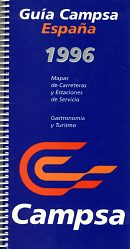REPSOL
Campsa, Petronor
Brief History
Repsol's marketing operations can be traced to Campsa, which was established in the 1920s as the Cia Arrendataria del Monopolio de Petroleos SA to act as the national Spanish petrol distribution monopoly. After Spain's accession to the European Community, the Government was required to break up the monopoly and in 1992 opened up the downstream petrol markets to competition. Repsol was formed by the state in 1987 to acquire the refining and upstream oil activities previously owned by the Government's INH (Instituto Nacional de Hidrocarburos); it took its name from a lubricant brand marketed by REPESA (Refinería de Petróleos de Escombreras). As the Campsa marketing was broken up, Repsol ended up with a majority of the assets and continues to operate Campsa as a secondary brand. As part of the splitting up of the old monopoly a number of new petrol brands came onto the scene; of these Petronor was also acquired by Repsol.
Repsol has expanded rapidly in South America, first by acquiring the Astra company in Argentina which participated in the Eg3 branded service stations. It also controls an oil refinery and 640 stations in Peru. In 1999 it acquired YPF, the former Argentine monopoly oil company, in an audacious bid. To overcome monopoly problems, it then swapped its Eg3 chain for a number of Brazilian service stations formerly owned by BR, but this deal backfired some years later when the Argentine government expropriated Repsol YPF in 2012.
It has grown more slowly in Europe; a small chain in Britain (partly under the Anglo brand) was owned until late 2000 and at one stage it had a few stations in SW France. Today its only non-Spanish fuel retailing in Europe is in Portugal where it added the longstanding Shell chain to its own newer network.
Maps: Repsol
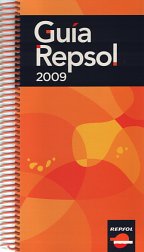 |
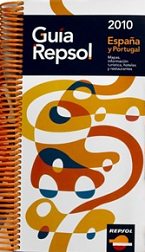 |
Repsol only started selling its keynote guide to Spain under its own name in 2009 - previously it had still used the long established Campsa branding. The guide consists of a boxed set of 3 volumes, centred round a spiral bound atlas with over 100 pages of fold-out maps of Spain & Portugal at 1:300,000 by TeleAtlas/Nexus, with 62 town plans and almost 300 pages of hotels and restaurants. The box also holds two other books: a 300 page guide to the best Spanish wines, and a 175 page colour guide to tourist routes through selected wine growing areas. The Guia Repsol is also freely available online. |
| Although the Campsa name was used on the main guide prior to 2009, Repsol did experiment with selling regional guides under its own name around 1999-2001. These covered just two areas: Catalonia and Galicia and contained maps and text in Spanish and local languages (Catalan/Galician), and were partnered by the Petronor guide to the Basque Country shown below. With no competing guide in Portugal, Repsol saw an opportunity to develop its own. The first one was produced for Expo '98 in Lisbon (below), but had fold out maps of Portugal by Guia Turistico do Norte. Most of the 300 page guide was given over to routes across Iberia to Lisbon, and around the city itself. |
 |
 |
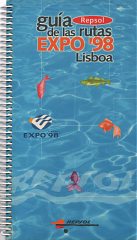 |
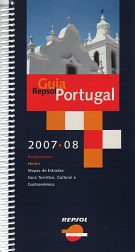 |
Regular Portuguese issues followed from 2001; like the Spanish atlases they contain maps at 1:300,000 by TeleAtlas, coupled to extensive listings of hotels and restaurants. Sheet maps are less commonly seen, but Repsol Portugal published a map of Iberia at 1:1mn by Forways in 2005. All the maps shown mark Repsol service station locations. | 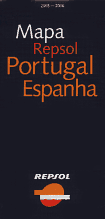 |
Repsol have also become the sole oil company advertising on Automóvel Club de Portugal maps, and the country page for Portugal shows an example from 2006/07 that marks all towns with Repsol stations.
Thanks to Pedro Bessa for sourcing the Portuguese map and atlases.
Maps: Campsa
|
No sheet maps are known from the old monopoly era. Around 1981 the Campsa Guia (guide) was started as a tall format spiral bound atlas and guide to the country, with a map section followed by a gazetteer featuring hotels and restaurants. In 1987, there were 34 folding maps to cover the country at 1:500,000, using cartography by Almax Editores. |
|
The Campsa Guide to Spain and Repsol Guide to Portugal come with companion volumes detailing wines, and a free CD-ROM. There is now an English language on-line version of the Campsa Guide.
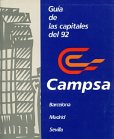 |
1992 was an important year for Spain, representing the 500th anniversary of Columbus's voyage to North America. To commemorate this event, it hosted the Olympics in Barcelona and mounted an international Expo in Sevilla. The Campsa guide included an additional book, produced in rather garish colours, giving practical information for visitors to these two cities and the European capital of culture for 1992, Madrid. It included 6 fold-out maps/plans - one for each city (lacking most street names and drawn in perspective), plus plans of the Olympic stadium, route of the Olympic torch and Expo 92 grounds. |
Maps: PetronorIt is not known for how many years the Guía Petronor del País Vasco en su entorno (Petronor guide to the Basque Country and its surroundings) was published, but it is thought that the 2006 edition shown here was the final edition. The guide was compiled by RBA Coleccionables, S.A. on behalf of Petronor/Repsol and included around 152 pages, including regional maps at the scale of 1:200,000. |

|
Text and layout © Ian Byrne, 1999-2012
All original copyrights in logos and map extracts and images are acknowledged and images are included on this site for identification purposes only.

